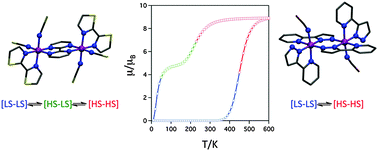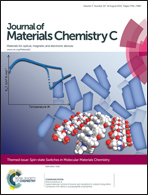Theoretical modeling of two-step spin-crossover transitions in FeII dinuclear systems†
Abstract
A computational methodology to model the spin-transition in dinuclear iron(II) systems [Fe(bt)(NCX)2]2(μ-bpym) and [Fe(pypzH)(NCX)]2(μ-pypz)2 (X = S, Se or BH3) is presented. Using the hybrid meta-GGA exchange–correlation functional TPSSh, accurate values for the thermochemical quantities associated with the different spin-states can be computed, and subsequently used to calculate the corresponding transition temperatures. This result also allows for the correct modeling of the spin-crossover curve, in agreement with the two-step or single-step nature experimentally reported for the transition. Our results indicate that the presence or absence of a two-step transition is mostly dominated by electronic effects, and the cooperativity between binding pockets plays a minor role. Insight on the electronic structure effects that enhance or suppress this behavior and its origin can be outlined from direct analysis of the relevant d-based molecular orbitals, which allows for a quantitative computational prediction to screen for new dinuclear systems with selected properties.

- This article is part of the themed collection: Spin State Switches in Molecular Materials Chemistry

 Please wait while we load your content...
Please wait while we load your content...